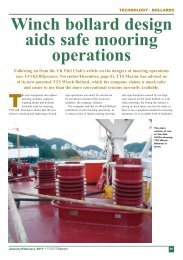Sideloading conveyor systems MARINE - TTS Group ASA
Sideloading conveyor systems MARINE - TTS Group ASA
Sideloading conveyor systems MARINE - TTS Group ASA
Create successful ePaper yourself
Turn your PDF publications into a flip-book with our unique Google optimized e-Paper software.
SIDELOADING CONVE YOR SYSTEMS<br />
The sideloading <strong>conveyor</strong><br />
system can be supplied with<br />
single, double or triple transport<br />
lines, each line comprising one<br />
lift with <strong>conveyor</strong>, one deck<br />
<strong>conveyor</strong> on each deck level and<br />
a common loading platform<br />
with <strong>conveyor</strong>s for on- and offloading<br />
from the shore side (see<br />
Figure 2).<br />
By introducing the outer<br />
elevator as shown in Figure 1,<br />
the depth of the shell cutout is<br />
reduced and the lifting height<br />
for forklifts on the quayside<br />
at high tide or in light-ship<br />
conditions can be reduced<br />
accordingly. The buffer <strong>conveyor</strong><br />
between the elevators enables<br />
them to work independently.<br />
The loading platform, which<br />
houses the buffer <strong>conveyor</strong> and<br />
the outer elevator, automatically<br />
adjusts its height relative to the<br />
quay, even when fully loaded.<br />
The complete loading process<br />
is monitored from a Man-<br />
Machine-Interface system (MMI<br />
Operating cabin<br />
Guiding column<br />
Deck <strong>conveyor</strong><br />
Paper reels<br />
Hold<br />
PC) located in the operating<br />
cabin where the operators also<br />
have full visual contact with<br />
cargo movements. Control of<br />
operation is automatic or semiautomatic<br />
by using infrared light<br />
status from the forklift trucks,<br />
or can be manual by using<br />
operators onboard the ship.<br />
Among other things, the<br />
control system features loadingsequence<br />
tracking (by light<br />
signals); cycle times; a count of<br />
the number of pallets loaded;<br />
safety devices and fault-finding<br />
tools.<br />
The side door<br />
The most commonly installed<br />
side door is the standard <strong>TTS</strong><br />
single unit upward sliding and<br />
tilting door. Alternatively a tophinged<br />
upward folding type can<br />
be deployed.<br />
The sliding and tilting side<br />
door has been installed in a<br />
number of ships since 1987<br />
and this proven and reliable<br />
Hydraulic lifting gear<br />
Lift<br />
Bulkhead<br />
door<br />
Fig. 1 – side loading <strong>conveyor</strong> system with outer elevator<br />
Side door open<br />
Sliding/lifting frame<br />
Loading platform<br />
Outer elevator<br />
Quay<br />
Counterweight<br />
hydraulically operated side<br />
door is supplied complete<br />
with hydraulic and mechanical<br />
equipment for easy and rapid<br />
installation. Opening is achieved<br />
by sliding the door upwards and<br />
then tilting it above the elevator<br />
tower to form a rain shelter<br />
above the loading area.<br />
Quay maximum height<br />
Loading platform<br />
with <strong>conveyor</strong><br />
Fig. 2 – side loading <strong>conveyor</strong> system with loading platform<br />
www.ttsgroup.com


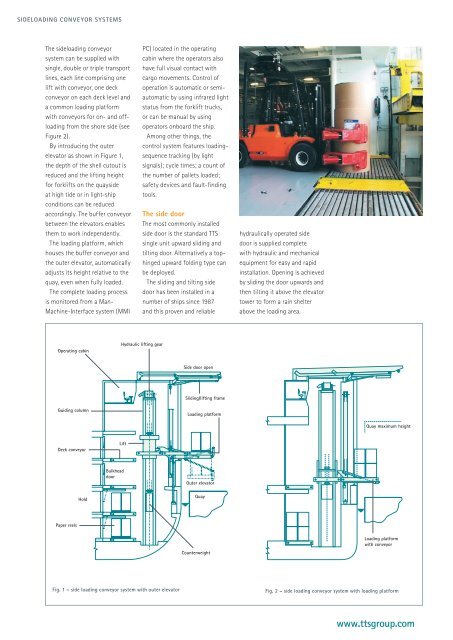


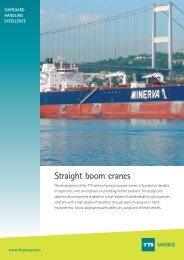

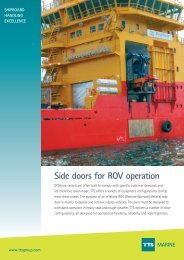
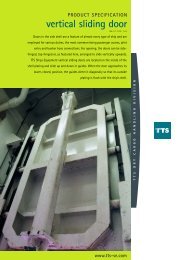
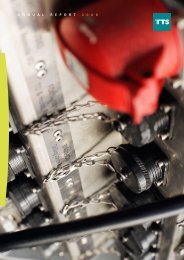


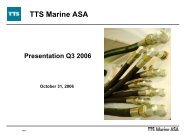
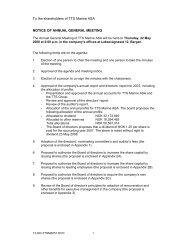
![2012.MasterPresentation_final [Compatibility Mode] - TTS Group ASA](https://img.yumpu.com/4612021/1/190x146/2012masterpresentation-final-compatibility-mode-tts-group-asa.jpg?quality=85)


